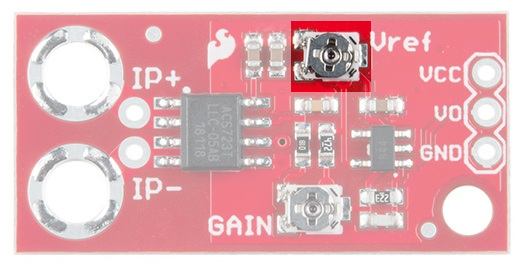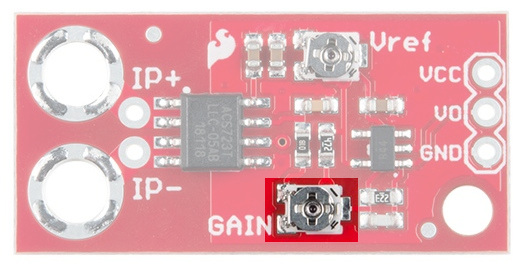Current Sensor Breakout (ACS723) Hookup Guide
Hardware Overview
This section will explore the various segments of the breakout with particular emphasis on the Low Current version.
 |
 |
| ACS723 Breakout Board closeup | ACS723 Low Current Breakout Board closeup |
ACS723 Breakout Details:
Both versions of this breakout board have the following attributes:
- Analog output with bandwidth adjustable to 80kHz.
- The bandwidth on the ACS723 Sensor Breakout width filter has been set to 20kHz to reduce noise when using at high gains. The full 80KHz bandwidth that the sensor is capable of can be recovered by closing the JP1 (Bandwidth Select) jumper on the back of the board. See either the ACS723 schematic or the ACS723 Low Current schematic for more details.
- Measures DC and AC currents from around 10mA up to 5A
- Full electrical isolation of measured and sensed circuits
- The version without the op-amp has a base sensitivity of 400mV/A
In addition to the above, the Low Current Sensor Board has the following:
- Adjustable sensitivity with on-board amplifier, gain from 2.2 to 22 V/V
Below is a list of all the pins broken out on the ACS723 and their functions.
| Symbol | Description |
|---|---|
| IP+ | High side of current sensor |
| IP- | Low side of current sensor |
| GND | Must be connected to ground |
| Vo | Voltage output proportional to current flowing through IP+ and IP- |
| VCC | 5V power supply |
To measure a current using this device, the current must flow through the IP+ terminal and out the IP- terminal (it will work in the other direction, but the measurement will be negative). IE: These terminals must be in series with the circuit that the measured current is flowing through. Note that both IP+ and both IP- terminals are connected to each other, you can use either (or both) of them.
Amplification (Low Current Sensor):
The amplified version of the breakout board (ACS723-Low Current) has two potentiometers on it: Vref and Gain.
The Vref potentiometer sets the baseline voltage output. In other words, it adjusts the voltage seen at Vo when there is no current flowing through the sensor (0 mA). This allows the sensor to output negative current readings as well as positive.
The gain potentiometer sets the sensitivity of the device. For example, if the gain is set high, then a smaller current will cause the voltage output to increase more, giving you higher sensitivity and allowing you to sense smaller currents.
However, there are a couple caveats:
- With higher gain you will see more noise (spikes) on the output, so smaller currents will be harder to measure accurately.
- If you are trying to measure larger currents with a high gain setting, your output will saturate or clip and reach the maximum 5V or 0V.
With that in mind, to get meaningful data from the current sensor, you must configure the Vref and Gain potentiometers properly.

